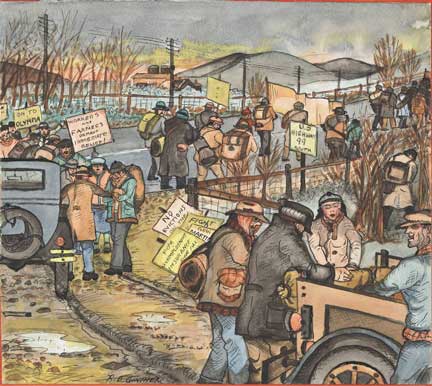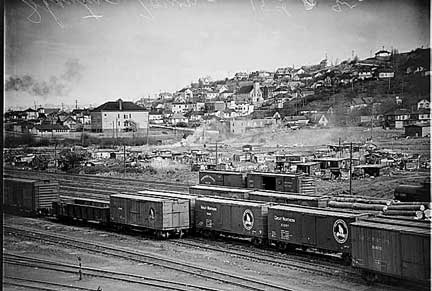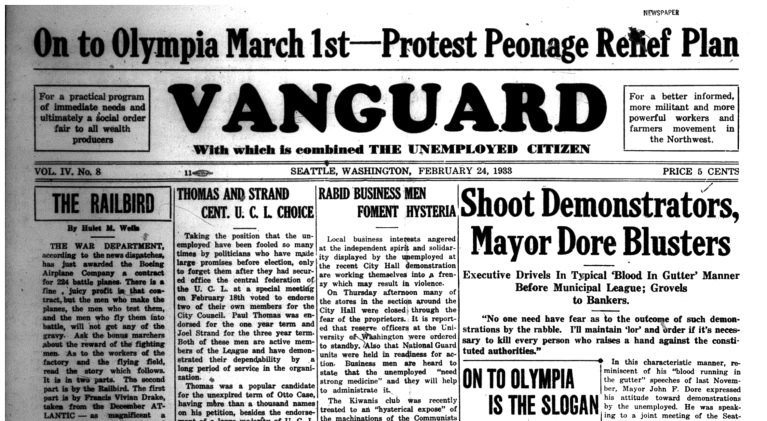What Percentage of American Families Was Living Below This Level During the Depression?
Economics and Poverty

The unemployed organized a "hunger march" on the country capitol of Olympia in March, 1933, pictured here past Depression-era artist Ronald Debs Ginther. 'About Tacoma, Washington. March 1933. The Peachy Low. King Co., and Seattle Contingent, Washington Land Hunger March on Olympia.' 1933. (Belongings of Washington State Historical Social club, all rights reserved.)
The stock market crash of October 1929 signaled the start of what became known equally the Keen Depression. Falling stock values helped undermine consumer conviction and business organisation investment, leading to a precipitous economic refuse that spread from the The states to other countries and continued for most three and a half years. Not until the jump of 1933 did the American economy begin to recover.
Washington experienced the crisis in means that were somewhat different than other states. The economy had been highly dependent on extractive industries, especially woods products. A government report explained that the economic system of the region "largely resembles that of a colonial possession, exporting raw and semifinished materials" while importing "nigh of the common manufactured articles."[ane] Forest products, agriculture, fishing, and mining accounted for about of the country's exports and many of its jobs on the eve of the Low, but the state's cities, where most of the population lived, too produced jobs based on trade, commerce, small-scale manufacturing, and professional person services.
Far from Wall Street, Washington residents were slow to react to the events of Oct 1929. Equally the stock market place tumbled, the Seattle Times reassured readers in a big headline that in that location would be "No Low."[2] Indeed, job losses were minor for the first yr. Just the optimism faded toward the end of 1930 equally banks began to fail, stores airtight, and unemployment surged.
Policy makers then managed to make things worse. In the nation's upper-case letter, President Herbert Hoover presided over a series of decisions that accelerated and globalized the economical refuse. In Olympia, the country legislature, meeting early in 1931, passed a bill to help the unemployed and stimulate the economy with an ambitious program of public works projects. They also passed a state income revenue enhancement to take some of the burden off property taxes. Governor Roland Hartley vetoed both measures and preceded to slash spending, equally did many of the cities and counties. Banking company failures, business organisation failures, and job losses accelerated.
Unemployment rates exceeded the national boilerplate just were kept lower than in states like Michigan and Ohio where so many jobs depended on one or 2 massive industries. Hardest hitting in Washington, as in many states, was the building and construction industry where payrolls past late 1932 were about 10 per centum of what they had been iv years earlier. Logging and sawmills saw employment drop by at least fifty percent and payrolls nonetheless farther. But employment in food processing, the transportation sector, utilities, and road construction held up even at the lowest betoken of the Depression, and a few smaller industries, notably pulp and paper mills, actually added jobs and expanded payrolls in 1932 and 1933. Overall, information technology is estimated that full income payments in the state fell past 45 percent by 1933 which was similar to the boilerplate reject for the nation as a whole. But at least one third of Washington's labor force was unemployed in early 1933, with however college rates in Seattle and other cities where the jobless congregated. These rates were higher than the national boilerplate, which is idea to have peaked at 25 percent.[3]
Poverty and homelessness

Hooverville in the Interbay neighborhood of Seattle, 1938. Courtesy of the Museum of History and Industry Photograph Archives.
Click to see more than Seattle Hoovervilles.
Since the government provided no unemployment insurance, lost jobs apace translated into lost homes and extreme poverty. In 1931, tent camps and shack towns began to appear. One large encampment that residents called "Hooverville" --in laurels of the President whom they blamed for the Depression--grew in the mudflats southward of downtown Seattle near Elliott Bay. Metropolis authorities ordered the site burned but it was rapidly rebuilt, becoming in time a nearly all-male customs of more than 1 chiliad residents. Tolerated by regime, information technology remained occupied until torn down by the urban center in 1941.
Until 1933 when federal aid began, it was up to local authorities to assist unemployed residents. Counties and cities did what they could, establishing work programs more than often than directly relief, only declining taxation revenues made it hard to do very much. Even every bit the need to assistance soared in 1931 and 1932, Seattle, like many other cities, actually cut welfare budgets as businesses closed and homeowners defaulted on taxes. Churches and charities too helped as more fortunate residents ofttimes gave generously to feed and clothe the poor.[3a]
Founded in mid 1931, the Unemployed Denizen'due south League demanded more funds and dissimilar kinds of programs for the unemployed and forced city officials to get out Hooverville alone. With clubs in nearly neighborhoods of Seattle and Tacoma and several other cities, the UCL advocated self-help production, setting up cooperatives to exchange products and services. Farmers donated food in exchange for labor; carpenters, dentists, and seamstresses exchanged i kind of skill for some other. In Seattle, UCL was then popular and powerful that the city's relief office used it to distribute public resources to the poor. For two years, as the economy went from bad to worse, the UCL helped some of the unemployed maintain themselves.
Recovery, 1933-1937
When Franklin Roosevelt assumed office in March 1933, the economic system was nearly stalled. Congress speedily passed a sequence of emergency measures to rescue the cyberbanking arrangement, send emergency aid to united states, and begin to re-utilize the millions who were out of piece of work. Federal funds to Washington State were funneled through the Washington Emergency Relief Administration, a state agency that dispersed some coin straight to the poor in the form of greenbacks grants while also launching dozens of public works projects that created new jobs. Before long there would be more than jobs coordinated with federal agencies. The Noncombatant Conservation Corps (CCC) would utilize thousands of immature men in the forests and national parks of Washington State. The Civil Works Adminstration set up up small public works jobs, while the Public Works Administration planned huge new infrastructure projects that included Bonneville and 1000 Coulee dams on the Columbia River. In 1935 many of the jobs and construction programs were consolidated nether the Works Progress Administration (WPA).
With federal assist, the state economy began a dramatic recovery, faster than many other states. By 1937, income payments in Washington (our best measure of economical activity) had returned to 93 percent of the 1929 level. Nationally, the level was 88 pct. Employment in the region's key industry, forest products, keyed the recovery. In 1937, there were nearly as many workers employed in the woods, sawmills, paper mills, article of furniture, and forest products factories as in 1929, although wages remained well below normal. Other parts of the economy had rebounded, though not and so dramatically, but the recovery was soon thwarted when the over-confident Roosevelt administration cutting spending in an effort to balance the federal budget. The national economy and state economies now descended into a second depression, which economists euphemistically labeled a "recession," coining the term that ever since has been used to depict economic downturns.[4]
Renewed federal spending pulled both the state and nation out of the 1937 recession. When census takers nerveless information almost employment in March 1940, the Washington jobless rate stood at 9.9 percent with some other 5.3 percent working on WPA and CCC projects. This was close to the national average that month.[five]
But the days of unemployment were soon to end. With war looming, the federal government needed planes and ships and Washington would build both. The new electricity generated by Bonneville and other Columbia River dams would power the shipyards of Vancouver and the Puget Audio. Cheap energy made Seattle into one of the nation'southward aircraft capitals, as new electricity-hungry aluminum plants provided what Boeing needed to build America's bomber squadrons.
By the finish of 1942, 150,000 workers labored around the clock in the country'due south shipyards and aircraft factories. Not only was the Low a retention, the land was now looking at its new economic system, based more than on planes than on trees, and firmly rooted in new industries that the federal infrastructure investments of the 1930s had made possible.
Copyright (c) 2009, James Gregory
Side by side: Hoovervilles and Homelessness
Click on the links beneath to read illustrated research reports on economics and poverty during Washington State's Dandy Depression:
 | Why Washington Land Doesn't Accept an Income Tax: The 1930s Entrada for Taxation Reform and the Origins of Washington's Taxation System by Nathan Riding Washington's tax organization proved inadequate to the growing needs of Washington Land's infrastructure. The 1930s saw a wide-based move for an income taxation in the state, led by rural farmers in the Washington State Grange. Stiff political opposition prevented the adoption of an income tax, which it notwithstanding does non have today and which constrains public spending and social services. |
 | On to Olympia! The History Behind the Hunger Marches of 1932-1933, by Ali Kamenz During the early 1930's, the poor and unemployed participated in a series of marches on the capitol in Olympia to demand food, work and housing. In one case at that place, they encountered indifference, hostility, and violence from elected officials, local police enforcement and vigilantes. The Vanguard, a Seattle-based publication affiliated with the Labor Higher, and the Unemployed Citizens' League, played key roles in march planning and organization. |
 | The Banking Crunch of 1933: Seattle's Survival during the Cracking Depression Bank Closures, by Drew Powers The nationwide banking crunch of 1933, brought on by corruption, client loan defaults, and an unstable banking system brought beginning land-wide and then nation-wide banking concern closures in 1933. Seattleites developed different strategies for surviving without greenbacks, while Roosevelt and Congress stabilized American capitalism and preserved public faith in American finance. |
 | Seattle's "Hooverville": The Failure of Effective Unemployment Relief in the Early 1930s by Magic Demirel "Hoovervilles," shanty towns of unemployed men, sprung upward all over the nation, named after President Hoover'due south insufficient relief during the crisis. Seattle'southward developed into a self-sufficient and organized boondocks-within-a-town. |
 | Self-Help Activists: The Seattle Branches of the Unemployed Citizens League by Summertime Kelly In the summer of 1931 a grouping of Seattle residents organized to plant self-help enterprises and demand that government officials create jobs and increase relief assistance to unemployed. |
 | The Unemployed Councils of the Communist Party in Washington State, 1930-1935 by Marc Horan-Spatz Following the stock market crash of 1929, the Communist Political party began to organize unemployed workers into Unemployed Councils. These bodies both provided aid to the needy and served as a tool to build mass back up for the Political party and its political program. In Washington State, the Councils were in direct competition with the Socialist-led Unemployed Citizens League, which led to tensions betwixt the two organizations. |
 | Organizing the Unemployed: The Early 1930s past Gordon Blackness As elsewhere in the country, Washington State'south Communist Party helped to organize the unemployed into agile political and social formations. In Washington, the Unemployed Citizen's League and its paper, The Vanguard, gained the state Communists a broad appeal, and integrated the unemployed into the state'due south radical reform coalitions. |
[1] Pacific Northwest Regional Planning Commission, Migration and Evolution of Economic Opportunity in the Pacific Northwest (Portland, 1939), 26.
[ii] Seattle Daily Times, Oct 27, 1929, p.1
[3] Pacific Northwest Regional Planning Committee, Migration and the Development of Economical Opportunity in the Pacific Northwest (Portland: National Resources Planning Board, Region 9, August 1939), p.95 and p. 154, Table 2. Also run across data assembled by John Adrian Rademaker, "The Measurement of Occupational Employment and Earnings in the Country of Washington" (MA Thesis, University of Washington, Seattle, 1935).
[3a] William H. Mullins, The Depression and the Urban West 1929-1933: Los Angeles, San Francisco, Seattle, and Portland (Bloomington and Indianapolis, Indiana: Indiana University Press, 1991), 95-105.
[four] Ibid.
[five] U.S. Census Bureau, Sixteenth Census of the The states: 1940. Population. Vol 111. Labor Force. Part v. Table 1: Employment Status of the Population.
Source: https://depts.washington.edu/depress/economics_poverty.shtml
0 Response to "What Percentage of American Families Was Living Below This Level During the Depression?"
Post a Comment